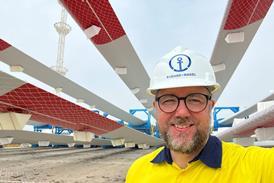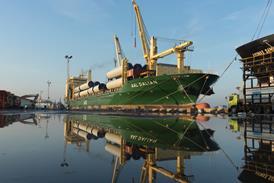A push to develop commercially viable floating wind turbines looks set to open up long-term opportunities for heavy lift operators, writes Phil Hastings.

The increasing international interest in floating offshore wind turbine (FOWT) technology was publicised in March when the European Marine Energy Centre (EMEC) in Orkney, Scotland, secured approval for a EUR31 million (USD35.1 million), four-year project off the west coast of Ireland.
According to EMEC, which is leading a consortium from Ireland, the UK, France, the Netherlands and Germany, funding for the project has been secured from Interreg North West Europe to accelerate the uptake of FOWT technology.
Subject to consent, a FOWT will be deployed for testing by 2022.
Another development earlier this year saw trade association RenewableUK launch a group to set out the FOWT industry’s strategy for large-scale deployment in the UK.
First FOWT farm
In that context, RenewableUK pointed out that the world’s first FOWT farm, the 30 MW Hywind project off the coast of Peterhead, Scotland, was commissioned by Norwegian multinational energy company Equinor (formerly Statoil) and Abu Dhabi renewable energy company Masdar in 2017.
“The UK’s existing leadership in offshore energy and abundant natural resources makes our waters the ideal test bed for this new technology, which has huge international potential as other countries seek to take advantage of the renewables boom,” claimed RenewableUK.
That technology could be suitable for installation in some US waters, for example, suggested Charles Dougherty, chief commercial officer of Atlantic OffshoreTerminals (AOT). “The idea of FOWTs is of great interest for the West Coast, which has considerably deeper waters than those found on the East Coast’s outer continental shelf, and various solutions are currently being explored,” he said.
Commenting on the overall worldwide potential of FOWTs, an Equinor spokeswoman said recent years had seen significant cost reductions in both the onshore and bottom-fixed offshore wind energy sectors.
“Floating wind is expected to follow a similar downward trajectory over the next decade, making it cost competitive with other renewable energy sources,” she added.
BigLift Shipping moved some of the components destined for the aforementioned Hywind project – a development comprising five turbines, each with blades measuring 75 m.
Turbine transport
BigLift’s work involved transporting the upper sections of the turbines from Bilbao in Spain to Stord in Norway on three sailings operated by some of its Tra-type heavy lift vessels.
The cargo included five top sections, each measuring 41.5 m in length and weighing just over 191 tonnes; five upper middle sections of 22 m/184 tonnes; five lower middle sections of just over 16.5 m/203 tonnes; and bottom sections each weighing 150 tonnes.
Francisco Rodrigues, business development offshore renewables for ALE, also championed the prospects of this emerging sector.
“We identified the FOWT sector as a market of high potential a couple of years ago due to its specific requirements, for example in relation to heavy structures (more than 3,000 tonnes), and infrastructure challenges. To date, ALE has been involved in several FOWT projects in Scotland, France, Spain and, more recently, Portugal,” he said.
This article is taken from HLPFI’s July/August 2019 edition.
















